#korth mountain father
Explore tagged Tumblr posts
Text


Battle of Korth Mountain-Father and Nathramar
Morrighan’nan versus Luthias Dwarfson
my contributions for @legend-markzine
#dragon age#dragon age fanart#korth mountain father#nathramar#morrighan‘nan#luthias dwarfson#avvar#legend mark zine#zazrichart#procreate#rebelle
112 notes
·
View notes
Text
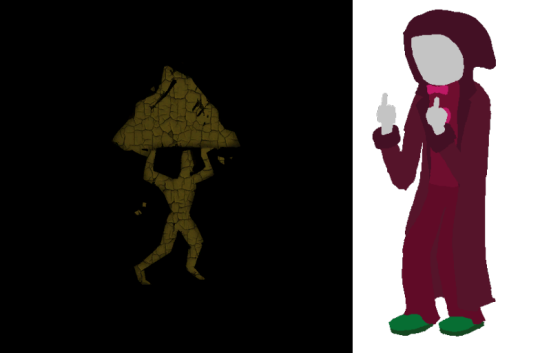
A hypothetical god tier for Korth the Mountain-Father from Dragon Age: the Lord of Heart.
A Lord of Heart is among those who are masters of the individual’s impact. They are motivated by themselves to be a master of instinct. (x) The Lord of Heart’s will takes precedence over everything else and they are invested in self discovery. (x) They are the Outlier Free Spirit, defined by domination and instinct. (x) Their opposite and inverse is the Muse of Mind. They share their personality with no one, as a master classpect. The Lord of Heart would quest on a planet similar to the Land of ??? and Heart, reigned over by Aphrodite (Goddess of Love) or Yaldabaoth (Devourer of Souls). They would rise to ascension on the wings of ladybugs. (x)(x)(x)
#korth the mountain father#korth#dragon age#lord of heart#character classpecting#classpecting#homestuck#my post
1 note
·
View note
Text
you know what's always frustrated me about dragon age tho
the religions
they're built on shaky (or zero) foundations.
all major real world religions have SOME kind of powerful reason that people choose to believe in them - they're all deeply rooted in occult metaphysics, NDEs and cosmic mystical events, secret esoteric knowledge, human history, myth, generations upon generations of human blood and ritual and ceremony.
andrastianism is basically catholicism but we don't know why people believe in the maker. we just know that they do.
people believe in jesus christ as the son of god because there is powerful evidence of him existing, powerful spiritual truths there, powerful legends prophesying his existence, and powerful history (it's of course deeper than that but this isn't a post about christianity).
it's understandable why people believe in anrdraste as a goddess-figure, as she has a powerful legend.
people believe in "god/ the universe/ source/ brahman/ allah/ 'the force'" (different names for the same concept) because spirituality is an inherent part of existence, it is a foundational truth of our reality that can only be experienced individually and not (yet, quite) proven by science (unless you get into quantum mechanics and einstein's theories and so on). it requires faith, and faith only comes from experiencing "knowing" directly. it cannot be taught, and it cannot be measured.
we know next to nothing about why people would ever be convinced by the maker enough to believe in him/ it as a god.
the elder scrolls does religious lore REALLY well. the aedra and the daedra have a creation myth that goes back to the two primal forces in the universe (anu and padomay - which are basically masculine and feminine primal forces, the yin/ yang of daosim - this ties into real world religions and makes the world of ES feel very real, because we can relate to it).
as far as i know, the only creation myth we get apart from the maker's "he was displeased by his creation and turned his back on it" is from the alamarri/ avaar with korth the mountain-father who created the mountains and provides game (a god worthy of being worshipped, to offer such foundations).
like, what does the maker even do? yeah he "created the golden city" (ehhhh??? not really thoooo????) and got mad at the tevinter magisters (that was just them poking at solas's fade prison too much tho)... and created the veil (that was solas tho). so nothing the maker has done has actually happened, it's the byrpoduct of something the evanuris did. mostly solas.
thedas (particularly with the dalish worship of the evanuris) feels like a post-apocalyptic world that lost its religion and its reasons for believing in religion a long time ago, because they've been continuously decimated by blights/ war/ slavery/ loss/ degradation.
and perhaps that is the truth of it. their faith is bleak, and rootless, because the world of thedas is a post-apocalyptic world that is bleak, and rootless (thanks to solas and the evanuris who created the blight, and sundered the titans from their dreams).
the most honest religions in thedas are, in my opinion, the dwarven religion (which is not a religion at all, and instead a worship of skill and excellence), and the avaar religion, which is based in their communication with the spirit world - which makes sense! because spirits are the energy of an idea or feeling, and that energy is tangibly spiritual and powerful. andrastianism is cool too, except for the part about it being founded on andraste being the bride of the maker, so we're back at square one.
what the fuck do these people even believe in?
#solas is the maker truthers this post is calling to u#i don't wanna see a single “why do they have to believe in anything” take. it's boring and that world view is shallow.#religion in fiction adds STAKES and Romance (gothic R) to death#bonus points if the religion ties back to real human esoteric secrets#like so much of dragon age does#there is a LOT of esoterica in dragon age#A LOTTTTT#so don't come talking to me about “why do they need religion”#they do because without religion the game wouldn't exist at all#you would literally have nothing to play#the entire franchise is deeply esoteric#from the sun symbolism of the chantry to the tarot card symbolism rampant throughout the games to the fade itself#it's all based in real life esoteric mystery teachings#iykyk#don't tell me the devs aren't spiritual or spiritualists#these games would be very different if that were the case#datv spoilers#datv#veilguard spoilers#solas posting#dragon age lore#dragon age the veilguard#dragon age#dragon age inquisition#dragon age origins#dragon age 2#dragon age religions#andraste#the maker dragon age#andrastianism
20 notes
·
View notes
Text
Alamarri lore is making me go insane because like
Korth the mountain father is the oldest and strongest of the avvar gods and has domain over the earth. He buried his heart deep within a mountain. He once answered prayers by sending dwarves. His throne was on top of Belenas, the mountain at the centre of the world, which was taken by the lady of the skies into her realm and then destroyed by a serpent
The lady of the skies has domain over the skies. She appeared to Tyrdda bright-axe as her elven lover to give her advice, including to not storm the golden city that demons were telling one of her suitors to storm
And also hakkon wintersbreath is there
7 notes
·
View notes
Text

Little Lady of the Skies
“According to Avvar legend, Korth the Mountain-Father kept his throne at the peak of the mountain Belenas, which lay at the center of the world and was so lofty that from it, he could see all the corners of the earth and sky.”
#ataraxie art#dragon age art#dragon age#dragon age origins#dragon age 2#dragon age inquisition#da art#artists on tumblr#ataraxie oc#avvar#chasind#dragon age oc#dragon age fanart#oc: herja
29 notes
·
View notes
Text
Dragon Age Iconic Patterns: The single spike

The single spike or horn has been a constant pattern throughout all games of Dragon Age in general and in DAI in particular. There are several things that may be linked to it, from Mythal and Andraste to Dragons. In this post we explore how many of these objects present such pattern and how this may be related in an integral way.
This post contains the following statues:
Andraste
Wyvern
Mythal
The red lyrium idol
Tevinter or Venatori outfits
Tevinter Dragon
Tevinter golems
Tevinter Colossus
Andrastian Free Marches warriors
[This post belongs to the series “Analysis and speculation of Statues”]
Andraste
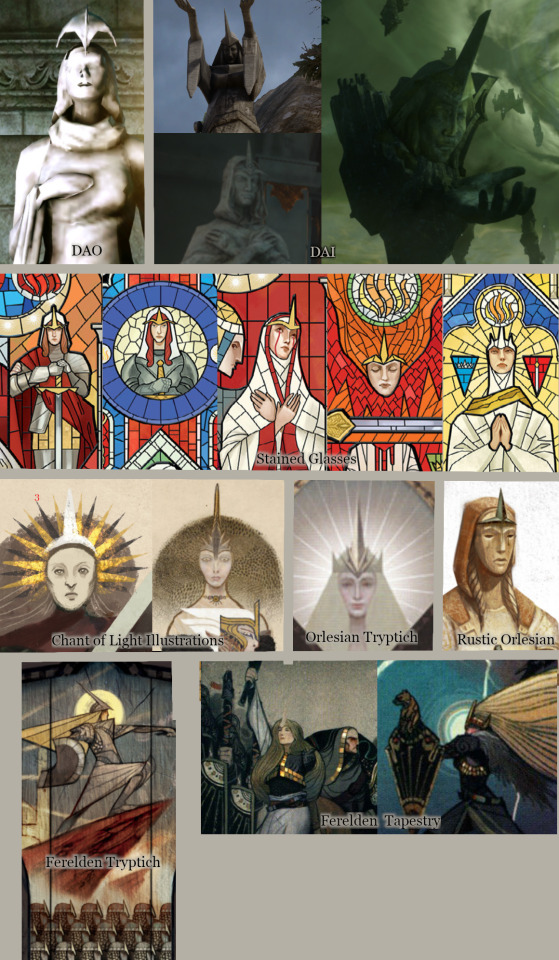
The main figure we see with a single-spiked helm in DAI is Andraste, who is depicted in numerous pieces of art along the game and books. Although she doesn’t wear this single-spiked helm in all of them, it’s an iconic representation of her [to the point that some followers are depicted with similar tiaras/helms such as Meredith]
In DAO we only have one unequivocally representation of Andraste, which is the statue we see at the end of the Temple of Andraste where her ashes are supposed to rest. In this case, the helm has the shape of a “moon” or similar. This form will be changed since DA2, and it will turn out to be the iconic single spike. We can attribute this inconsistency to the many difficulties in resources and environmental telling that DAO had.
Most of the time, Andrastian art represents Andraste with this single spiked helm/tiara [more details in Andrastian Statues].
In the illustrations found in the Chant of Light we can suspect that such a single spike is related to the shape of one single sun ray.
Wyvern

These animal statues appear all over Ferelden and in some parts of Orlais and in the Frost Back Mountains. In the tag Ferelden Wyvern we can track their presence along DAI. That they appear in Ferelden is not surprising, but the fact that they are inside ancient Pre-Blight Tevinter ruins [check Western Approach: The Still Ruins, Main Chamber and Hall of Silence and Western Approach: The Still Ruins, Viridis Walk and Inner Sanctum] is very disconcerting, specially taking into account how central it is in The Still Ruins, which appears even in the loadscreen of the zone. One could suspect this may have been product of the Dragon fascination that Tevinter culture had/has. Still, it seems odd to honour a lesser creature such as a Wyvern when they usually worshipped the true Dragons.
This statue appears in the Fade as well, but it has a clear design choice: the game shows us a wyvern in front of a head of Andraste, pushing us to ask why such an irrelevant statue would be in front of something so important as it is Andraste. The answer is solved later in the book World of Thedas, where we find that there is a Ferelden Tale which related wyverns with Andraste:

Now, this Tale is quite curious. If we always keep in consideration that this piece of lore is highly unreliable since it’s a tale spread in a population via oral narration, and subjected to changes over ages without records, we can highlight several details:
Andraste goes to the Mountain to “reach the Maker”. In the Chant of Light, we know that she speaks with the Maker, who is described Mountain-like. This reinforces the idea that Maker=related to Mountains. I assume this is a cultural remnant of the alamarri/avvar origin of Andraste, who had a deeper relationship with Korth, the Father-Mountain.
Andraste sang, and with this song, a “wyvern” appeared. This may potentially bring some relationship with the Dragons and the original song I talked about in posts like The Silent Grove, Those Who Speak, and Until We Sleep. We can even suspect that maybe instead of a Wyvern, the original event that inspired this Tale may have related a true Dragon. After all, we know that this single spike in the wyverns may, potentially, have some relationship with the dragon shape of Mythal. We also know that Tyrdda had an elf lover who sent a dragon to help her people, so I wonder to what extent the Alamarri and Avvar had also some level of relationship with mountain dragons.
It’s still a big question to understand how this wyvern statue, so related to Ferelden culture, appeared in pre-blight Tevinter buildings, when Ferelden did not exist as it is now. This is what reinforces my question: are these wyverns potentially creatures related to the Great Dragons? So far, we have no answers.
Mythal

Mythal, in all her representations and shapes, also wears an iconic single spiked helm. Even in the Concept Art, where we can see wavy sided horns that did not make it into the game, we cannot mistake the single centred spike. In dragon shape or in her humanoid form, this spike is constantly present.
It is unclear how this design choice may potentially speak to the player to relate Mythal to Andraste. One can speculate that, maybe, a fragment of Mythal appeared to Andraste. Maybe the Maker that Andraste claims to hear was, in fact, Mythal’s fragment. It would have been very convenient for Myhtal to instruct Andraste to make her Exalted March on Tevinter if we keep in mind that Flemeth [another fragment of Mythal] has been altering History to push it into a direction she has been planning for ages.
Flemeth’s Tiara
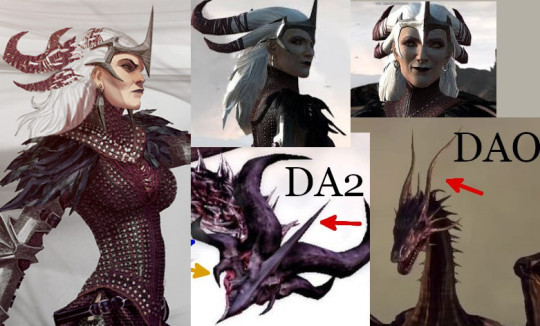
Flemeth’s tiara also has a structure that shows a single central spike in a very prominent way. The relationship is obvious: Flemeth is Mythal. Or at least, a surviving fragment of her.
Her dragon shape is different in DAO than in DA2. In DAO it’s the model of a general high dragon [as usual, DAO didn’t have the most variety of visual resources so we can’t read too much in it], while in DA2, Flemeth has a clear dragon shape with a single spike in its horns that can be related to that tiara.
The red lyrium idol

The Red Lyrium Idol also shows a prominent central spike in the head. It’s a constant symbol that allows us to do some speculations: in the post Attempt to rebuild Ancient Elvhenan History I speculated that Mythal's assassination may have inspired this idol, and therefore, this single spike seen in the idol is what relates it to Mythal herself.
It’s curious that even when Meredith turned into a piece of Red Lyrium, she also displayed a single spike in her head. This may have been just a consequence of the helm she was wearing in that last battle, which was clearly a helm trying to emulate Andraste’s.
From a design point of view, I think it’s clear that the game is telling us that this idol is related to Mythal/Flemeth, even though we are still blind about the “how”.
Tevinter or Venatori outfits
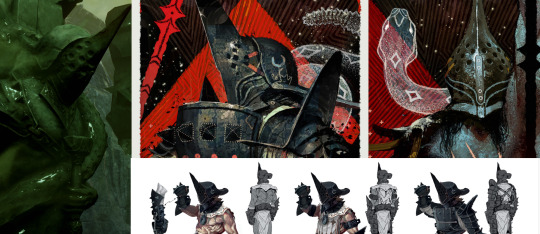
I already spoke about this in the section “outfits” in Patterns and Styles: Tevinter. We know that Tevinter has a long history of dragon cults, and until the moment the nation turned into the Andrastian Faith, the Old Gods Cult was its strongest religion. The fact that a dragon [Mythal] has a single spike horn, and Andraste also has this icon in her art, makes us hard to understand the origin of the symbol in Tevinter Design. It could have been due to the Dragons, but also, as a design choice once they were converted into the Andrastian Faith. Let's remember that Dorian tells us that Tevinter thinks that Andraste was a mage, so more reasons to have her icons among the Tevinter Warriors since they have mage-inspired armours.
I also explained that it's hard to differentiate the Venatori from non-Venatori Tevinter design simply because the Venatori are nationalist, so they will always use the most iconic symbols of their nation.
There is a strange link between this design and the one I called “The Free Marches Andrastian Warriors”, which display a strong Tevinter-like style, but remaining Andrastian. These statues may keep that single-spiked helm as a representation of Andraste, but also as a remmant of Tevinter design [more details in Andrastian Statues].
Tevinter Dragon

For completion’s sake, I add this detail: these typical Tevinter dragons display a single horn. At some point one wonders if these statues are related somehow to the design of the Wyverns or are a development of worshipping Mythal-dragon.
Tevinter golems

These Tevinter golems trigger the codex the Gate Guardians . They are metallic statues that, we are told, were powered at some point by bars of lyrium.
They also display a single spiked helm, that, due to the general looking of the golem, looks like a Tevinter representation of Andraste herself.
The golem in general has resemblance to some pieces of the armour of the Humanoid Mythal.
Let’s remember that Golems were developed by Dwarves during the First Blight, and due to their trade relationship with Tevinter, they sold some [Golem and Legend of the Juggernaut] that were displayed on the entrance of Miranthous, inactive. So it seems that, historically speaking, makes sense that these golems may have been developed into resembling Andraste since Tevinter embraced the Andrastian Faith after the beginnig of the First Blight [check all this in the integral post The Chantry and the Mythology of the Chant of Light]
Tevinter Colossus

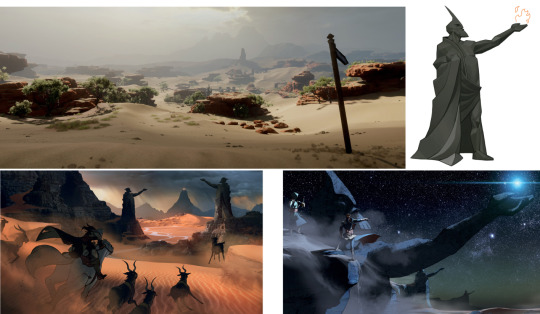
Among the Tevinter sculptures, we find one of the most mysterious one: the colossus. They are found closer to the structures that belonged to Tevinter in pre-blight times.
In game there are three different Colossus, found in Western Approach: Coracavus; Front Corridor and South Entrance, in the open of Hissing Wastes: scattered objects and ruins, which was being co-opted by Orlesians to make it into a sculture of an Orlais Emperor, and inside the Frozen Gates in Frostback Basin [DLC]: Frozen Gate.
The book World of Thedas gives us more concept art about these structures, which seem to be related to “guiders” and, maybe, to astronomy too.
The fact that we can see one of these in a concept art, showing up a certain star over its hand, makes me suspect these statues belonged to the ancient Dreamer times, that the codex Astrariums claims that Tevinter was under before the Magisterium was the mandatory political system.
The heads of these colossus are not exactly single spiked heads, but one of them [The Coracavus' one] has one single spike that fuses with the bridge of its nose, while the other two, have "horns" backwards. Maybe we can suspect some dragon inspiration in them? I find their profile very similar to the Qunari ones’.
Andrastian Free Marches warriors

These were seen for the first time in DA2, and they decorated The Chantry of Kirkwall. They look similar to the Tevinter Warriors thanks to this spiked helm and pointy shapes, but this may be attributed to the fact that Free Marches have a strong Tevinter influence.
However, these statues have an unmistakable robe identified with the ones worn by the Chantry priests in DA2.
This single spike in their helms may be related to Andraste herself and her own helm/tiara, but also having some inspiration from Tevinter.
Conclusions
I think it’s fair to say that the “Single Spike” is an unequivocally symbol of Andraste that may have an inspiration or a relationship with dragons in general, or with Mythal in particular. By extension, and due to Mythal’s dragon nature, this Single Spike also appears in Tevinter culture, even in elements that are suspected to be pre-Blight, and therefore, impossible to be inspired in Andraste herself. So, as it happens with DA lore, and assuming what we did in the post Attempt to rebuild Ancient Elvhenan History, everything comes to primordial dragons that may have inspired this icon in Tevinter Culture and later, in the human tribes, from where the Andrastian Myth and her religion raised.
#single spike#single horn#mythal#Humanoid Mythal statue#Dragon Mythal statue#tevinter dragon#tevinter#free marches#free marches design#the colossus#tevinter golem#venatori#red lyrium idol#flemeth#andraste#andrastian design#andraste statue#Ferelden Wyvern#Analysis and speculation of Statues
53 notes
·
View notes
Text
The “Flip it” Theory
(I’m sorry, it’s like 3am and I couldn’t come up with a better title. lol)
So.. Here’s another fun little DA tinfoil hat theory that you might have already heard about, but I don’t think I’ve seen it discussed on here before? It also probably sounds super unhinged, but at this point, can we even get any more unhinged in terms of theories? lol So, we might as well just embrace it. It’s just one of those theories that simply won’t leave my mind (especially when trying to sleep at 3am lol), so writing it down will hopefully put it to rest. 😁
Okay, so we all know that, in the Fade, the laws of gravity or physics in general don’t really apply and are all over the place, right? There’s no real sense of time or space, no real “up” or “down” as the Fade does not follow any rules of the waking world and is somewhat shaped by whatever the person dreaming expects reality to look like or quote, “is reflected by the mind of the living”.
So when we see the Inquisitor fall into Fade in “Here Lies the Abyss”, it’s even emphasized by how the camera movement in-game and the environment in the Fade has to “adjust” according to how the Inquisitor expects gravity to work, or rather, what the world’s supposed to look like to us, meaning the sky has to be up and the ground has to be down. lol
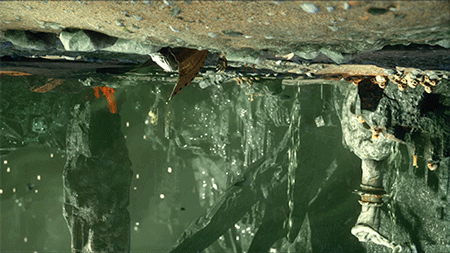
Additionally in Trespasser, we see that, not only is the Vir Dirthara scattered all over the place, but in parts also completely flipped upside down.

(I’m so sorry btw, I just now realized that looking at these gifs for too long can make you feel super dizzy. lol)
The reason I’m pointing this out, is because it keeps reminding me, for one, of this mural.
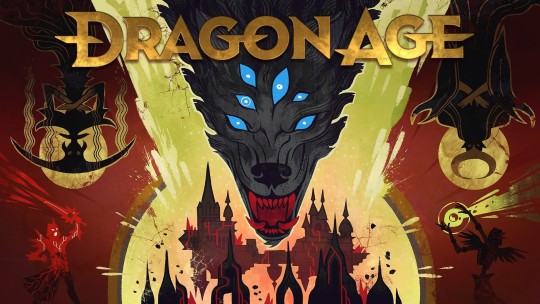
Of course, since this mural was first shown in the teaser trailer in 2020 and has been thoroughly analyzed by the fandom, it seems pretty clear by now that, with the way this mural is composed, particularly with the two upside down figures, BioWare intentionally encourages us to look at this image upside down. What’s even more intriguing to me, seeing as the Dread Wolf appears to break into the Black City here, “releasing” the raw magic of the Fade with its non existent rules of reality to the waking world and in doing so, figuratively and in some respects quite literally “turning the world upside down”.
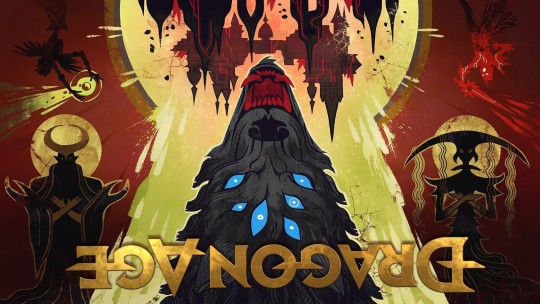
Though while most people seem to focus on the two figures here (that are most definitely the two remaining Evanuris still sleeping/imprisoned or something like that, but that’s not the topic of this post lol), you might have heard of this other crazy theory suggesting that, when looking at this mural upside down, the shape of the Dread Wolf appears to roughly resemble that of a mountain.
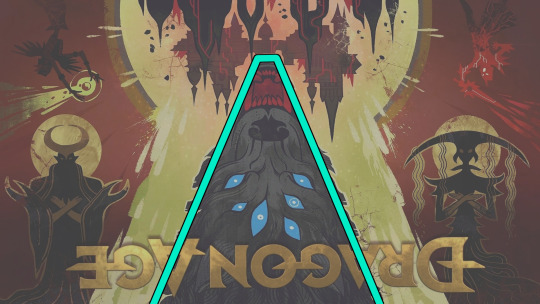
(I warned you this leans VERY heavy on the tinfoil hat, but please don’t leave yet lol) Okay so, as far as I understand it, the theory suggests a potential connection to a particular mountain mentioned in the lore, called Belenas.
In a legend of the Avvar, it is said that Korth the Mountain-Father kept his throne at the peak of the mountain Belenas, which “lay at the center of the world”. The tale goes as follows:
Korth took his heart out of his chest and hid it within the Frostback Mountains to avoid being weakened by love. When his lack of heart turned him bitter and cruel, the Lady of the Skies sent her children to retrieve it. Though after all her children had failed to do so, the ptarmigan volunteered for the search. The Lady refused to give the tiny bird her blessing, as she thought the mountains was too fierce, but the ptarmigan succeeded where everyone else had failed. It found and freed the heart, allowing it to jump back into Korth's chest, where Hakkon Wintersbreath bound it once again. For her great deed, the ptarmigan was honored by the gods.
When Korth grew tired of heroes barging into his hall to claim the honors they thought they were due for climbing the mountain of the gods, he spoke to the Lady of the Skies, who then lifted Belenas from the earth into her realm, so no one could reach it anymore.
Legend says that Belenas was eventually destroyed during a battle between Korth and the serpent Nathramar, leaving only a vast crater behind that the Lady of the Skies “filled with her tears” and formed what we now know as Lake Calenhad.
Okay, so there’s a lot to dissect here, so I try to make it as brief as possible, but in short, people have noticed a number of intriguing parallels to different pieces of elven lore and theories in this tale, or what could be interpreted as such.
So I’m going to try and take this on one by one. Let’s start with this:
- Korth’s throne sits at the peak of mountain Belenas, at “the center of the world”.
- When looking at the mural from the teaser upside down again, it places the Black City (or the “Maker’s throne”, if you will) at the “peak” of the Dread Wolf shaped “mountain”. It is also known that the Black City sits at “the center of the Fade”, where no one is able to reach it.
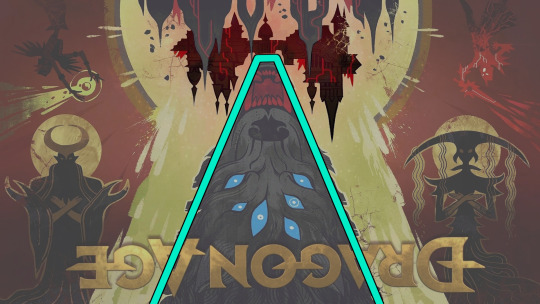
- Korth takes his heart out of his chest and hides it within the Frostback Mountains. When his lack of heart turns him bitter and cruel, the Lady of the Skies sends her children to retrieve it.
- If we put in “Titan” for Korth and “Mythal” for the Lady of the Skies, this part is kinda reminiscent of what we know (or suspect) of Mythal, her conquering of the Titans (which would be the Frostback mountains in this comparison) and the theory of the ancient elves killing the Titans and obtaining their hearts, enabling them to create the foci/orbs/vessels of dreams that gives them god like powers. So Mythal sends out her “children”/army in the attempt to conquer the Titan and obtain its heart.
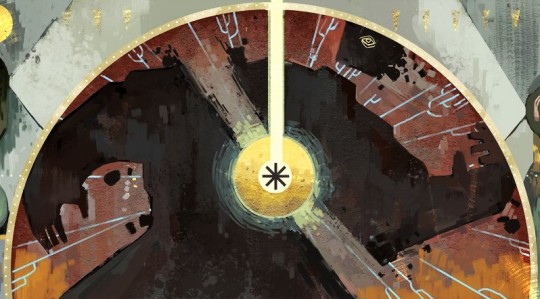
- After all the Lady’s children fail, the ptarmigan volunteers for the search. She refuses to give the tiny bird her blessing, as she thinks the mountains are too fierce, but the ptarmigan succeeds and retrieves the heart.
- Now, this part might be a bit of a reach, but when taking this even further and comparing this whole story to Mythal’s war against the Titans, looking at this tiny little nondescript bird defying the odds and ultimately leading the Lady of the Skies to “victory”, am I the only one who’s a little reminded of Greek mythology here (which, as I’ve mentioned numerous times before now, seems to be at least partially BioWare’s inspiration for the ancient elves), and how in Greek mythology, the Olympians’ victory over the (literal) Titans was the result of a cunning trick devised by Prometheus, who deserted from the Titans’ army beforehand.
And I know I’m certainly not the only one to have noticed a lot of odd similarities between the role of good old Prometheus in mythology and our very divisive Mr wanna-be-Wisdom Pride, aka Solas.
- For her great deed in retrieving Korth’s heart, the ptarmigan is honored by the gods.
- So while we’re at it, why not just compare the little bird to Solas then and assume that, for helping Mythal in her victory over the Titans and obtaining its heart, Solas is somehow honored and elevated to the status of godhood or at least into some sort of exclusive circle of those who the Evanuris trusted the most. (And even rewarded with his own orb, maybe? Might this be what we’re seeing in the mural depicting a Titan’s death?)
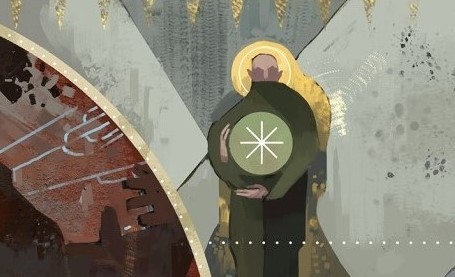
- When Korth grows tired of heroes barging into his hall to claim the honors of the gods, the Lady of the Skies lifts Belenas from the earth into her realm, so no one can reach it anymore.
- Now it gets a bit tricky.. If we take this part of the tale as Mythal “lifting” the now dead Titan into her own realm, meaning the sky, maybe it’s nothing more than a metaphor for Mythal mining the Titans’ blood and using the lyrium for her own empire (the creation of bodies for spirits?). Or maybe she literally lifted part of a dead Titan’s body into the sky and used it as a “cornerstone” to build the empire’s capital city Arlathan on top of it.
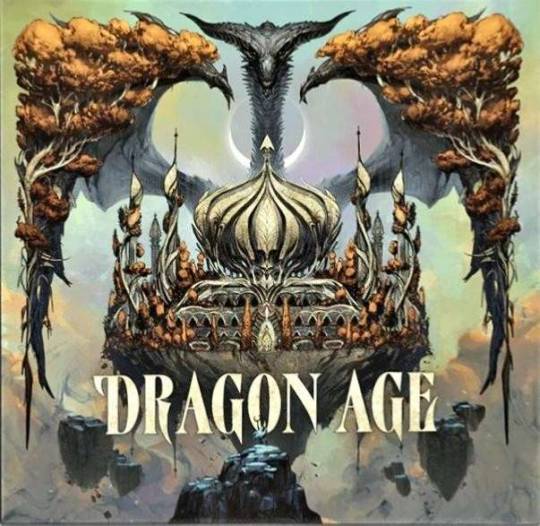
Which, again, would actually explain why the Black City *cough* Arlathan *cough* is depicted on top of the “mountain” in the 2020 upside down mural. Especially when adding that last part “so no one can reach it”, you know, just like the Black City can’t be reached within the Fade.

- Belenas was eventually destroyed during a battle between Korth and the serpent Nathramar, leaving only a vast crater behind that the Lady of the Skies “filled with her tears” and formed what we now know as Lake Calenhad.
- Again, this part could be interpreted in many different ways. I’ve seen theories spanning from Solas creating the Veil causing the magical floating Arlathan to fall from the sky and destroying the mountain in the process, to the Lady’s “tears” actually being Mythal’s (Great dragon) blood that somehow dripped in the lake when she was murdered, which is why centuries later, the actual Calenhad Theirin would gain special powers when he made a bargain with an old witch (Flemeth?) and drank from said lake.
So yeah, as you can see, there’s a lot to take from all this as far as unhinged tinfoil theories and strange parallels go. lol
And with all of this in mind, I’d like to look at the Black City in the 2020 teaser mural again, as you also might have notice that, in addition to the whole mountain shaped Dread Wolf, when turned upside down, the Black City appears to keep the silhouette of a city, no matter how you look at it?
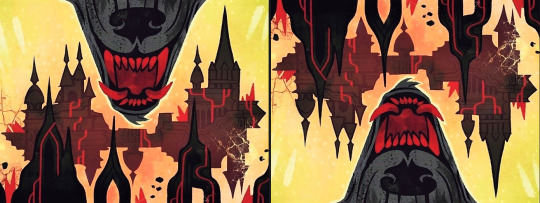
In fact, a lot of depictions we’ve seen of the Black City share this rather oddly shaped silhouette.

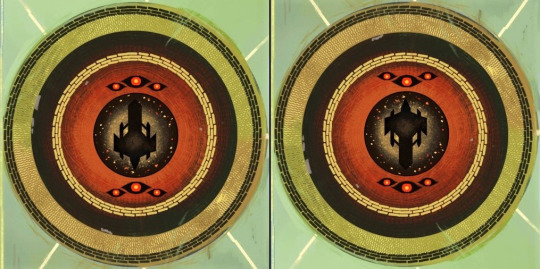
There’s also this stained glass, depicting the city upside down and in both gold and black.
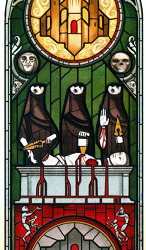
I actually don’t know what to take from all this. It’s just something I’ve noticed while gathering images. lol
But while we’re at it and flipping everything on its head now.. lol While I was looking at all the Trespasser murals again, I also noticed that, when flipped upside down, two of the murals actually form a full circle when put together.
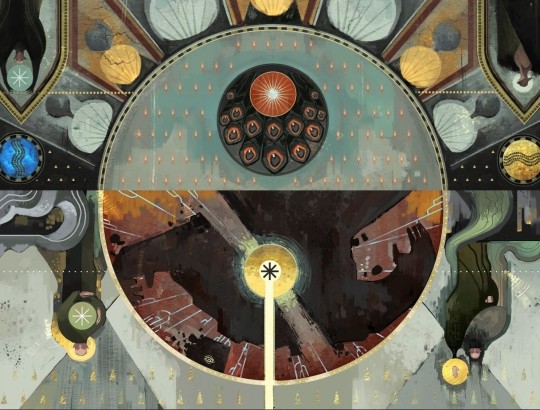
And ohh, would you look at that, there’s the “mountain” (Titan) at the bottom again with the Black City “on top” of it, just like the mural in the 2020 teaser when flipped upside down?? 😂 (Also interesting parallel to note with Solas holding the orb(?) on both the left side of each mural.)
Now, I know I sound super unhinged and I actually don’t think this is supposed to mean anything and it’s probably just a crazy coincidence (..right??), but.... what IF we just go full on tinfoil here now and assume that it IS actually supposed to be looked at this way......
In all the murals we’ve seen thus far, the circle was always assumed to represent the Veil, right? So when looking at it this way, it would put the Titan inside the Fade within the Veil beneath the Black City, right?
So.. Here’s my crazy idea...
Even though we know the Fade is an ever-changing place not bound to any rules of reality or a set geography.. What if the rocky landscapes we see in the “raw Fade” are actually all part of a sleeping/dead Titan(s)?
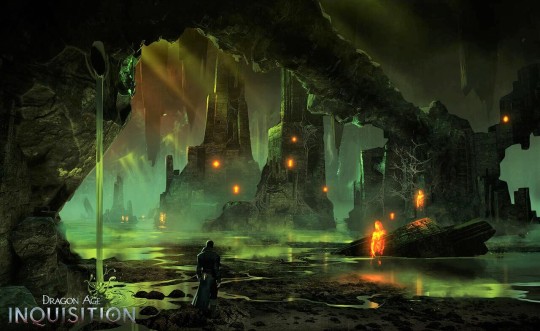

And while we are looking at these rocks again, am I the only one reminded of the structures seen in the deepest level of the The Descent dlc, a gargantuan cavern located in the so called “Wellspring” within a Titan, which is grouped at the expedition table as a location within “the Uncharted Abyss”.

“The Abyss”, also called the Void in different cultures, myths and historical texts in DA lore, is said to be a place whose location is undefined, but believed to be somewhere within the Fade, “empty places between dreams” (or, according to Solas, the place where spirits are reborn).
So if we go back to the Wellspring again, where we’re looking at what appears to be a literal abyss, a vast sea of clouds.. What we expected to be the deepest and darkest place in the world is revealed to be a bright, seemingly endless “sky” beneath the earth, or rather a Titan.
And with all this in mind, it’s even more intriguing now to go back to the beginning of this post, where we established that, in the Fade, the sky is not set to be “above” or “beneath”. It all depends on the expectation or perspective of the beholder.
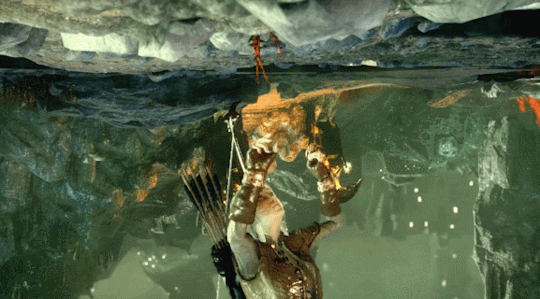
(And btw, funnily enough, I actually encountered a bug once at the Wellspring that made it look like the sky was actually “falling down” on me. lol)
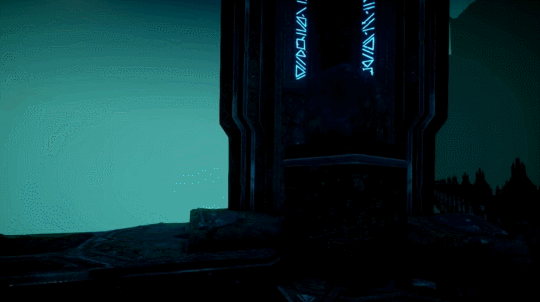
And lastly, in relation to all of this, I also want to point out this little quote, said by Flemeth in DA2:
“The world fears the inevitable plummet into the abyss.”
While we all know our favorite old witch likes to be overly ambiguous and cryptic in her phrasing, maybe we should take this quote more literal than we previously thought? lol Maybe, with the Veil collapsing some way or another and the angry tainted Titans awakened, the world might literally lose its so called “Pillars of the Earth”, plummeting into the endless void we’ve seen in The Descent.....
Well, shit.
Anyway, I’m afraid that’s all I had to say lol, and if you actually made it this far, thank you so much for engaging in this insanity. 😁 (And sorry if this turned out to be a total waste of your time. 😂)
Though I do have to mention, what actually prompted me to write this post in the first place, was seeing how some people are expecting Solas to be at the White Spire now after reading the synopsis of the upcoming comic series “The Missing” (if you want to know why, skip to the end of this post lol). The White Spire being an Antivan mountain with a very particular shape (at least according to this illustrated map of Thedas that came with every copy of Tevinter Nights).
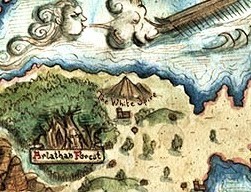
(I can see where this thing got its name from. lol It almost reminds me of a volcano? 😂)
Which just so happens to ALSO kinda resemble the shape of the “upside down mountain” shaped Dread Wolf from the 2020 mural....

So.. take from this information whatever you like, because I don’t know anything anymore... My head hurts from all this spinning. I’m out. 🥴
#tinfoil time#trespasser#solas#mythal#da4#dragon age 4#this is probably the most tinfoil I'll ever get lol#but this one is so much fun to think about for some reason 😂#anyway good night lol
102 notes
·
View notes
Note
I have been thinking about the obvious chess metaphor ever since learning the Veilguard PCs name
Would you say there's a connection? Are you a rook?
Yeah same!!! Im obsessed with it, especially after the chess' banter with Bull in DAI where Solas sacrifices his two towers to win the game with a mage and a pawn.
I think there's definitely a connection because Mark Darrah announced the game forever ago with a drawing of a Rook piece with a wolf's head on fire on top (which together, make the Lighthouse, the guide to freedom as it was intended)
I think it means Rook can do massive swept accross the board even if some limitation means they won't be able to be flexible enough to avoid some of the greater sacrifices that comes with a game of chess when played against gods.
Another meaning that i think is interesting is that Rooks are also birds, and Leliana's raven tower (under which Solas stayed to literally learn how she spies) was named the Rookery. A Rook also therefore involve the imagery of a small bird that can sneak in difficult situation a regular person cant.
Which makes me think about the codex entry "A Tale of the Frostback" in DAI where we learn that when Korth the Mountain Father burried his heart deep inside so no one could hurt him and it made him cruel, the Lady of the Skies sent birds to try to infiltrate the mountain to find his heart and only the tiniest of birds managed its way through.
I think it shows Rook evolution as a pawn, to a piece we never truly see coming. Underestimated, easy to sacrifice, but sometimes instrumental. The fundation Solas needs to still guide the people to his true goal, as well as a person small and insignificant enough that you dont see them coming (compared to the Inquisitor that was a larger than life person directly at the start of the game)
But yeah!!! Many thoughts
And i do think being a Rook is cool 😎
4 notes
·
View notes
Text
Codex Entry #96: The Frostback Mountains
Even mountains had a heart, once. When the world was young, Korth the Mountain-Father kept his throne at the peak of Belenas, the mountain that lies at the center of the world, from which he could see all the corners of earth and sky. And he saw strong men become weak, brave men grow cowardly, and wise men turn foolish for love.
Korth devised a plan that he might never be betrayed by his own heart, by taking it out and hiding it where no soul would ever dare search for it. He sealed it inside a golden cask, buried it in the earth, and raised around it the fiercest mountains the world had ever seen, the Frostbacks, to guard it.
But without his heart, the Mountain-Father grew cruel. His chest was filled with bitter mountain winds that shrieked and howled like lost souls. Food lost its flavor, music had no sweetness, and he lost all joy in deeds of valor. He sent avalanches and earthquakes to torment the tribes of men. Gods and men rose against him, calling him a tyrant, but with no heart, Korth could not be slain. Soon there were no heroes left, either among men or gods, who would dare challenge Korth.
The Lady of the Skies sent the best of her children—the swiftest, the cleverest, and strongest fliers—to scour the mountains for the missing heart, and for a year and a day they searched. But sparrow and raven, vulture and eagle, swift and albatross returned to her with nothing.
Then the ptarmigan spoke up, and offered to find the god-chief's heart. The other birds laughed, for the ptarmigan is a tiny bird, too humble to soar, which spends half its time hopping along the ground. The Lady would not give the little creature her blessing, for the mountains were too fierce even for eagles, but the ptarmigan set out anyway.
The little bird traveled deep into the Frostbacks. When she could not fly, she crawled. She hugged the ground and weathered the worst mountain winds, and so made her lonely way to the valley where the heart beat. With all the god's terrible deeds, the heart was far too heavy for the tiny bird to carry, so she rolled it, little by little, out of the valley and down a cliff, and when the golden cask struck the earth, it shattered. The heart was full almost to bursting, and the pain of it roused the mountain god to come see what had happened.
When Korth neared his heart, it leapt back into his chest and he was whole again. Then Hakkon Wintersbreath bound Korth's chest with three bands of iron and three bands of ice, so it could never again escape. And all the remaining gods named the ptarmigan honored above even the loftiest eagles.
—"The Ptarmigan: An Avvar Tale," from Ferelden: Folklore and History, by Sister Petrine, Chantry scholar
#i have a soft spot for tales ok?#dragon age#dragon age the veilguard#dragon age dreadwolf#a codex a day keeps the dreadwolf away#avvar
3 notes
·
View notes
Text
Codex entry: The Avvars
"Driven across the Frostbacks in ancient times, the Alamarri tribesmen split into three groups: one settled in the Ferelden Valley, one was pushed into the Korcari Wilds, and the last returned to the mountains. Modern Fereldans bear little resemblance to their Alamarri ancestors, and the Chasind remember few of their traditions, but the Avvars have changed little throughout the ages.
Like the Chasind, the Avvars are not a united people. Each tribe fends for itself and is beholden only to its thane. They still follow their own gods: Korth the Mountain-Father, Hakkon Wintersbreath, the Lady of the Skies, as well as dozens of animal gods never named to outsiders.
Nothing lasts in the mountains. Wind and rain eventually eat away the strongest holds. Valleys that were arable one generation are locked in year-round ice the next. Game is constantly on the move. Even among themselves, the Avvar make no absolute promises: they wed by a tradition in which the groom struggles to untie a tightly knotted rope while the bride sings a hymn to one of the gods. However many knots he has undone by the time her song ends is the number of years she will spend with him. Lowlanders often forget that there is no such thing as a permanent alliance in the Frostbacks."
—From Ferelden: Folklore and History by Sister Petrine, Chantry scholar
5 notes
·
View notes
Text
{Spoilers-Theory} Old Gods = Elvhen Gods Part 3 1/2
Originally posted 1st April 2024
I must apologise for the delay -- RL got away from me but I'm back for Part 3! Buckle up because we are going to deep dive into the deepest roads of the fade where Epiphany dwells.
I had planned on delving headlong into the coincidental similarities between the Old Gods and Evanuris and positing my own individual matches, citing connections and contradictions for each however I believe there is still much more contextual evidence to support and weaken the theory before that so...welcome to Part.3
Recap for Part 2:
Solas personally does not consider himself one of the Evanuris.
Mythal was considered one of the Evanuris. One of the best of them.
Honourable mentions:
Evanuris and The Forgotten Ones
{Elvhen, God-Spirits and the Maker}
Gaider and the BioWare team have outdone themselves with the creation of such a diverse and complex setting as Thedas. Codex entries give us passive insight and world-building without the use of exposition and railroading the storyline – allowing us to consume the information at our own leisure. It's within these Codex entries that we find the most worldbuilding and contextual information rather than the narrative of any given instalment with the Dragon Age franchise. Creatives have used RL events, religions and mythologies as the basis for fictional works for hundreds, if not thousands of years. Dante’s Inferno could be considered one of the earliest known self-insert fanfics in the modern era. George RR Martin’s A Song of Ice and Fire has many parallels with numerous mediaeval historical events, including but not limited to the Hundred Years War and the War of the Roses.

[Illustration of ‘The Hero’s Journey’ from Wikipedia; here]
The monomyth itself describes the common heroic narrative and cannot at all be directly connected to the multiple religions that it is present in, surely? In essence - no. The ‘Hero’s Journey’ formula is perhaps older than organised religion and as old as the human race itself, and its presence is so widespread is perhaps a product of the great global journey as modern humans migrated out of Africa.
The monomyth is an example of something pre-existing being adopted and adapted by multiple cultures. In the ancient world, this also included adopting and adapting deities, especially if their roles were similar. Perhaps evolving from the same root, as observed by the Roman and Greek pantheon?
If we look at RL mythologies and how they evolved we can perhaps gather some insight into how Thedosian cultures and mythologies evolved outside of canon information garnered from in-game codex or literature.
Polytheism has two subcategories; hard polytheism and soft polytheism. “Hard” polytheism is the belief that all deities are distinct and separate rather than considered to be archetypes or personifications. “Soft” polytheism, also known as omnitheism, posits that different gods may either be archetypes, personifications of nature, or essentially the same god but interpreted differently by different cultures.
If the Old God = Elvhen God theory is proven to be true, this would be a case of omnitheism.
Apart from the Old God = Elvhen God theory, soft polytheism is prevalent in Thedas and Dragon Age. This is seen in human tribes that either predate and/or fall outside of the Andrastianism and the Chantry, especially the Avvar and Chasind as their practices have endured into the Dragon Age.
The Avvar and Chasind are sister cultures, both descending from the ancient Almarri before splintering off into the Frostbacks and the Korcari Wilds, respectively. As sister-cultures they have diverged and evolved unique practices, however they both come from the same root and retain similarities, most notably the shamanistic traditions and shared spirit-gods such as Korth the Mountain-Father, The Lady of the Skies and Hakkon Wintersbreath.
Although it has been previously alluded to in codex entries, the Jaws of Hakkon DLC for Inquisition gave us a first-hand experience of enduring ancient human customs as practised by the Avvar and how spirits and magic play an integral part in their traditions.
The three principal gods of the Avvar; Korth the Mountain-Father, Lady of the Skies and Hakkon Wintersbreath would be considered personifications of nature. Korth = Earth. Lady of the Skies = Sky. Hakkon = Winter/War.
Amund, the Sky Watcher we encounter in the Fallow Mire in the Inquisition base game has this to say about your encounter after defeating the Avvar and rescuing the agents:
Sky Watcher: Is this why the Lady of the Skies led me here? To help heal the wounds in her skin?
This dialogue compounds the personification aspect of soft polytheism of the Lady of the Skies, and by extension the entirety of the Avvar pantheon and how the Avvar perceive lesser spirits. It can only be assumed that the Avvar believe that all spirits - at least benevolent spirits that aid the Hold - are gods as per The Augur’s dialogue in the JoH DLC:
General: What was that? Those spirits? Inquisitor: Did you just… introduce me to spirits? Augur: The gods of the hold clamoured to see you. I obeyed, for I am their voice and their augur. And if I didn’t show you off, they’d hound me for months.
General: You said I “blaze like fire”? Inquisitor: What did you mean when you said I blaze like a fire? Augur: How do you think you appear to the gods of the Fade? To those beyond the Veil, your hand burns like the watchman’s bonfire.
Confused: Spirits see me? All the time? Inquisitor: Are you saying every spirit in the Fade knows where I am? Augur: Only those nearby, but thoughts spread quickly among the gods.
The very nature of spirits is hard to define due to how little we know, either due to erasure or conflicting information, and how integral they seem to be to the Fade and the various cultures in Thedas.
Spirits are denizens of the Fade and are formed by reflecting the material world through the narrow lens of its nature. A spirit’s nature can be nearly anything; compassion, wisdom, justice, valour, faith, choice etc. Most negative emotions; despair, envy, desire, rage, terror etc. are nowadays considered demons. Demons are typically created when a spirit's nature cannot be fulfilled and is therefore corrupted, although Solas explains it best in dialogue. The dialogue will be a mix of freely triggered conversations between the PC (Female Lavellan)/Solas and Solas’ personal quest dialogue branches, so I will try to keep them in chronological order of availability.
Herald: I’d like to know more about the Breach. Solas: Simply put, it is a tear in the Veil between this world and the Fade, allowing spirits to enter the world physically. Small tears occur naturally when magic weakens the Veil or when spirits cluster at an area that has seen many deaths. Herald: I’d like to know more about the Veil. Solas: Circle mages call it a barrier between this world and the Fade. But according to my studies in ancient elven lore, that is a vast oversimplification. Without it… Imagine if spirits entered freely, if the Fade was not a place one went but a state of nature like the wind. Option 1: That sounds marvellous. Herald: It sounds like it would be wonderful. Solas: And dangerous, but… yes. A world where imagination defines reality, where spirits are as common as trees or grass. Instead, spirits are strange and fearful, and the Fade is a terrifying world touched only by mages and dreamers. I am glad that I am not alone in seeing the beauty of such a world, along with the obvious peril. Option 2: That sounds strange. Herald: I don’t know if I can imagine that. Solas: Try. Imagine if spirits were not a rarity but a part of our natural world like… a fast-flowing river. Yes, it can drown careless children, but it can also carry a merchant’s goods or grind a miller’s flour. That is what the world could be, if the Veil were not present. For better or worse. Option 3: That sounds dangerous. Herald: We’ve got enough trouble with demons already. Solas: But would they still be demons? Or would they be part of our natural environment like… a fast-flowing river? Yes, it can drown careless children, but it can also carry a merchant’s goods or grind a miller’s flour. That is what the world could be if the Veil were not present. For better or worse.
This conversation tree is available from Haven and focuses more on the Breach and Veil, however, we do find out later in Trespasser that the Veil is an artificial construct of Fen’Harel’s design and we must take into account its influence on spirits and demons, even the very Fade itself. What we later come to know is that Solas is describing not what the world could be but rather what the world should be without the Veil’s influence upon Thedas and the Fade.
Herald: I’d like to know more about demons. Solas: Your Dalish say that demons hate the natural world and seek to bring their chaos and destruction to the living. Solas: But such simplistic labels misconstrue their motivations and, in so doing, do all a great disservice. Spirits wish to join the living, and a demon is that wish gone wrong. Option 1: Can we change that? Herald: Is there a way to coexist? To live with them, if not in peace, at least without such active confrontation? Solas: Not in the world we know today. The Veil creates a barrier that makes true understanding most unlikely. But the question is a good one, and it matters that you thought to ask. Option 2: I don’t believe that. Herald: I doubt those things pouring out of the Breach wanted to join the living. Eat, maybe. Solas: Of course demons are destructive. This world is illicit and unnatural for them. They fight to gain entrance, and when the rules of this world do not mirror theirs, they lash out. Tragic, but not evil. Option 3: I don’t care. Herald: It doesn’t matter why they attack us. Solas: Of course it does. The dog that bites you because it is rabid is not the dog that bites you because it is starving. You may kill either, but one is just a few scraps of meat away from being your faithful servant.
Again, this conversation is available from as early as Haven. “Spirits wish to join the living, and a demon is that wish gone wrong.” is a line that sticks with me, as it's often the dialogue branch I choose, and it explains the difference between spirits and demons without the use of metaphor or allegory. The other options use metaphors but do illustrate the need for fluid thinking and adapting to the circumstances of any given situation when dealing with a spirit.

[Memory transforms into a Pride Demon from Dragon Age: Absolution]
With that being said it can be assumed that spirits are the default state, and demons are the ‘altered’ state, the antithesis. But that oversimplification doesn’t explain the existence of wisps and the other states of being that a spirit can enter, as Solas explains in dialogue in his personal quest All New, Faded for Her.
Solas: You were a true friend. You did everything you could to help. I could hardly abandon you now. Inquisitor: I’m here for you. (Flirt) (Female Elf PC) [Investigate.] 1. Where were you? 2. What is death like to spirits? So it isn’t really dead? (Special) (Triggered by previous) Investigate, Option 1: Where were you? Inquisitor: Where did you go? Solas: I found a quiet spot and went to sleep. I visited the place in the Fade where my friend used to be. It’s empty, but there are stirrings of energy in the Void. Someday something new may grow there. Investigate, Option 2: What is death like to spirits? Inquisitor: What happens when a spirit dies? Solas: It isn’t the same as for mortals. The energy of spirits returns to the Fade. If the idea giving the spirit form is strong, or if the memory has shaped other spirits, it may someday rise again. Investigate, Option 2, follow-up: So it isn’t really dead? Inquisitor: You’re saying your friend might come back? Solas: No, not really. A spirit’s natural state is peaceful semi-existence. It is rare to be able to reflect reality. Something similar may reform one day, but it might have a different personality. It would likely not remember me. It would not be the friend I knew.
The knowledge we can garner from Solas is unique, as he’s an ancient elvhen, and therefore it predates the chantry and lacks censure. Wisdom’s demise is tragic, and although something in its place will reform it will not necessarily be the same. That begs the question; is a clone the same person? Genetically they are identical but they lack the same personality characteristics and experiences that have shaped and defined them then are they fundamentally two different entities?
Solas believes it to be so; the same locale in the Fade, the same knowledge and memories could shape the energies but if the fledgling spirit lacks the memories of their friendship, those experiences they shared, then this newly sentient spirit would be a stranger. Even if this new spirit retained their memories, would the trauma of their predecessor’s demise fundamentally alter their personality?
Solas’s responses between Option 1 and Option 2 leave it open for either to occur; that a new spirit of wisdom will form or his friend will reform; ‘it may someday rise again’.
It is open for interpretation, however, there is evidence that individual spirits can linger and retain their sense of self after their demise.
"A great deal is made of the most powerful demons, those that create abominations and those that have changed the history of Thedas. It is often forgotten that not all demons are such awe-inspiring beings. Some that break through the cracks in the Veil into our world are known as wisps, a sliver of a thought that once was. A wisp is a demon that has lost its power; either it has existed in our world for too long without finding a true host or it has been destroyed—often, so we've found, by other demons. What remains of its mind clings tightly to the one concept that created it—a hatred of all things living. While its ability to target a living creature is limited, these wisps often mindlessly attack when encountered in the Fade. In the living world, they often have been known to maliciously lure the living into dangerous areas, being mistaken for lanterns or other civilized light sources. This does, however, seem to be the very limit of their cunning." —From the journal of former Senior Enchanter Maleus, once of the Circle of Rivain, declared apostate in 9:20 Dragon Age
The codex entry for wisps in DAO, is unlocked after defeating a wisp wraith. Due to the codex author we must take it with a grain of salt, even though the Rivaini are more liberal they are still influenced by the Chantry, so do we choose to believe that wisps are only the remains of ‘malevolent’ demons or is it a state of being that all spirits can enter?
Are wisps solely the remains of ‘that once was’? The short answer is; that we don’t really know. The Wraith codex entry in DAI has this to say:
Like wisps, wraiths are sometimes thought to be the remains of spirits or demons that have been destroyed. They cannot shape the Fade around themselves, nor are they capable of mimicking forms they see in the minds of dreamers as many weaker spirits do. Instead, they are the scavengers of the Fade, dwelling in the shadows of stronger beings, feeding on scraps of thought and emotion. —From Beyond the Veil: Spirits and Demons by Enchanter Mirdromel
Now we know from World of Thedas Vol. 2 that the book quoted in the wraith codex is canon to Thedas and is ‘Chantry approved’. If we compare the information between the wisp and wraith codex, we can see that they both agree that wraiths and wisps are thought to be ‘the remains’ of spirits or demons and lack any true power to exert their will upon the Fade.
Gathering his magic, he reached his mind across the Veil and summoned a spirit through. It was tiny, a wisp of a creature with barely any consciousness to call its own. The shimmering orb hovered over the palm of his hand, its magical hum tickling the hairs on the back of his neck. “I need you to be quiet,” he whispered. “You can do that, can’t you?” The wisp bobbed excitedly and dimmed. He barely even saw it now. Tossing it up into the air, he sensed its excitement as it floated out into the commons. Even such a small spirit took great joy in coming into the real world. They found the oddest things of endless fascination; a wooden chair, a piece of steak, a feather. Left to its own devices, a wisp would bob around random objects for hours, making strange trilling noises as it explored its environment. The templars frowned on the use of even such benign spirits, although it was not strictly forbidden. The best healers, after all, summoned spirits of compassion to assist them. Such spirits did not linger and immediately returned to whence they came, but the Chantry looked upon any who had the talent to contact them with suspicion - such as himself. Still, it had its uses. [Excerpt from Dragon Age: Asunder. David Gaider. Pg. 58.]
In Asunder we see Rhys summon a spirit, it is described as ‘a wisp of a creature’, so is it a wisp or a spirit or are they interchangeable? Is a wisp just a spirit or demon that lacks a complex consciousness? What we do know, thanks to more recent Dragon Age media such as the novels that I am referencing, is that wisps can be summoned and they can be bound, and therefore follow the same laws as spirits and demons. In the short story The Dread Wolf Take You, from the Tevinter Nights collection, a Mortalitasi has bound what has been described and referred to in dialogue as a wisp.
“Interesting to see both Dalish and city elves working with this… thing.” The Mortalitasi grimaced, and then her eyes snapped down to her stirring stick, still moving of its own accord in her wineglass. “I see specks at the bottom, wisp.” Her voice held a warning, and the stirring stick jerked and moved faster. [Excerpt from Dragon Age: Tevinter Nights. The Dread Wolf Take You, Patrick Weekes. Pg. 491]
This wisp has been bound to a stirring stick to animate the object, a simple task, something that Rhys in Asunder mentions that is within a wisp’s capabilities.
At once, we were awake, back in the cavern, and its walls shook and cracked, and then a rift of green light rent the ceiling open above us and the demons that had accompanied the Dread Wolf burst into the world in righteous fury, shining warriors with blades forged from the raw Fade itself, and behind them, dimly visible through the crackling light, the shadow of the beast itself, from whose slavering jaws came the final words, roared not in anger, but with quiet contempt. “FROM THIS MOMENT, SHOULD YOU EVER BIND A SPIRIT, THEN YOUR LIFE IS MINE.” The hypocrisy almost made me laugh. The Dread Wolf forbade use from binding spirits, but why would these lesser demons attack us if not because the Dread Wolf bound them? They might have looked like spirits of Valor or Justice to the untrained eye, but I assure you, no kindly spirit would tear into us as these creatures did. [Excerpt from Dragon Age: Tevinter Nights. The Dread Wolf Take You, Patrick Weekes. Pg. 496-497]
Later in The Dread Wolf Take You, in The Mortalistiasi’s Tale we have ‘The Dread Wolf’ declare that if the Mortalitasi were to bind any spirits from that point on then their life is forfeit. This threat comes to pass later in the story and Solas releases the wisp/spirit from the stirring stick.
So we have gathered that although wisps and wraiths are ‘sometimes thought to be the remains of spirits or demons that have been destroyed’, they could potentially be the stirrings of a consciousness of a newly formed spirit? The latter has no basis other than the supposed ‘life cycle’ of a spirit in Solas’ dialogue in All New, Faded for Her, but it could be the reforming of a pre-existing consciousness. It would seem that spirits are immortal, akin to the mythological phoenix.
The franchise does have an instance similar to that of a reformed spirit regaining its consciousness. Mythal.
We discover in the main quest, The Final Piece, that Flemeth is Mythal or more accurately that Flemeth is Mythal’s mortal host. I will be referencing dialogue trees for a world state that has an Old God Kieran and the Elven Inquisitor drinks from the Well, with the help of The Genitivi Chronicles.
Inquisitor: You can’t be Mythal! That’s not possible! Flemeth: (Laughs.) Explain to me, dear (girl/boy), why I cannot be what I am. 1. I know what Mythal was. (Special) (If Elven PC) 2. You’re not even elven. 3. You’ re no god. 4. Mythal is long dead. Option 1 Inquisitor: Mythal was the goddess of justice. I’ve seen the statues. She…Flemeth: Was one of the People. Yes, indeed. Option 2 Inquisitor: Mythal was an elven god. You, you’re… Flemeth: Human? Flemeth laughs. Flemeth: Not a word many have used for me in a very long time. Option 3 Inquisitor: I’m supposed to believe that you’re some kind of god? Flemeth: Clearly not the sort you had in mind, hmm? Option 4 Inquisitor: Whatever Mythal was, she died long ago. Flemeth: So she did.
Option 1 and Option 2, have the characters confirm what we can deduce by observation. Mythal was elvhen. Flemeth is (or was) human. Option 4, on the other hand, confirms what Abelas had claimed in the Temple of Mythal that Mythal had been murdered, unlike the Dalish legend that she was banished to the Beyond with the Evanuris.
That confirmation that Mythal had died is crucial, and I will explain as to why later. The conversation that takes place within the Fade (as per the Old God Kieran world state) between Mythal, Morrigan and the Inquisitor is illuminating.
Flemeth nudges Kieran, and Kieran rushes over to hug Morrigan. Kieran: I’m sorry, Mother. I heard her calling to me. She said now was the time. Morrigan: I do not understand. Kieran returns to Flemeth’s side. Flemeth: Once I was but a woman, crying out in the lonely darkness for justice. And she came to me, a wisp of an ancient being, and she granted me all I wanted and more. I have carried Mythal through the ages ever since, seeking the justice denied to her. 1. She’s inside you? 2. This is too much. 3. Maybe that was a demon. Option 1 Inquisitor: Then… you carry Mythal inside you? Flemeth: She is a part of me, no more separate than your heart from your chest. Option 2 Inquisitor: You can’t expect us to believe that. Option 3 Inquisitor: That could have been a demon, lying to you.
…crying out in the lonely darkness for justice. And she came to me, a wisp of an ancient being… I have carried Mythal through the ages ever since, seeking the justice denied to her. Now this dialogue is either a great big fat red herring or it seems like Mythal is acting eerily similar to a destroyed spirit that has clung on and reformed into a wisp, hmm?
Flemeth: What do the voices tell you? The Inquisitor closes their eyes, listening to the whispers. Inquisitor: They say you speak the truth. Flemeth: But what was Mythal? A legend given name and called a god, or something more? Truth is not the end, but a beginning. Flemeth: So young and vibrant. You do the People proud and have come far. Flemeth: As for me, I have had many names. But you… may call me Flemeth. 1. Will you help us? 2. Am I your servant now? 3. What do you want? 4. Why stay secret? (Investigate) (Non-Elven PC) 5. You’re Morrigan’s mother? (Investigate) (Elven PC) - I need to understand. (Investigate/Special) (Triggered by either previous question) 6. The elves needed you. (Special) (Elf PC) 7. I know who Flemeth is. (History) Option 1 Inquisitor: I presume you know what we’re up against. Flemeth: Better than you could possibly imagine. Inquisitor: So will you help us? Flemeth: Once I have what I came for. Flemeth looks at Kieran. Option 2 Inquisitor: So must I serve you now because I drank from the Well? Flemeth: (Chuckles.) Is that how you see yourself? A servant? I have no commands for you. Not yet. Morrigan: Then what is it you want? Flemeth: One thing, and one thing only. Flemeth looks at Kieran. Kieran looks to Morrigan. Kieran: I have to go now, Mother. Option 3 Inquisitor: So you lured us here. What do you want? Flemeth: One thing, and one thing only. Flemeth looks at Kieran. Kieran looks to Morrigan. Kieran: I have to go now, Mother. Option 4 (Non-Elven) Inquisitor: If Mythal is within you, why not reveal yourself? Flemeth: And to whom should I reveal myself? Inquisitor: To the elves? To everyone? Flemeth: (Laughs.) I knew the hearts of men even before Mythal came to me. It is why she came to me. They do not want the truth, and I… I am but a shadow, lingering in the sun. Option 5 (Elven) Inquisitor: Then you’re Mythal and Morrigan’s mother? Morrigan: As well as a witch who prolongs her unnatural life by possessing the bodies of her daughters. Flemeth: That’s what you believe, is it? Morrigan: I found your grimoire, and I am no fool, old woman. Flemeth: (Chuckles.) If only that were so. My daughter ran from me long ago. I’ve let her be… until now, it seems. Option 5 (Triggered) Inquisitor: If Mythal is within you, why not reveal yourself? Flemeth: And to whom should I reveal myself? Inquisitor: To the elves? To everyone? Flemeth: (Laughs.) I knew the hearts of men even before Mythal came to me. It is why she came to me. They do no want the truth, and I… I am but a shadow, lingering in the sun. Option 6 Inquisitor: If Mythal is a part of you, why haven’t you helped us? We’ve called to you, prayed to you… Flemeth: What was could not be changed. Inquisitor: What about now? You know so much… Flemeth: You know not what you ask, child. Option 7 (If Elven) (History) Inquisitor: I know the name “Flemeth.” My people call you Asha’bellanar, the woman of many years, and speak of your legend. Inquisitor: It says, long ago, you left your husband for a lover. Your husband then tricked you, killed your lover, and imprisoned you. Then a spirit came to offer you vengeance. Mythal–that’s what you spoke of. Flemeth: One day, someone will summarize the terrible events of your life so quickly. But, yes, I was that woman. That is how my tale began. Inquisitor: Flemeth appears in other legends, helping heroes for reasons of her own. Flemeth: I nudge history, when it’s required. Other times, a shove is needed. (Chuckles.)
The initial dialogue tree after discovering that Flemeth is Mythal is a minefield of information that needs to be pieced together, it is such a shame that this tree cannot be exhausted and you must choose a branch. Option 1 has me curious, as this is during the Breach Crisis, the danger that Corypheus poses with his plan to assault the Black City with the aid of the Orb of Destruction, it seems that Flemeth is familiar with what? Corypheus? The Blight? The Orb? The Veil?
Option 2 and Option 3 offer little, except to reaffirm Flemeth’s interest in an OGB Kieran and that she now has control over the person who has drank from the Well of Sorrows.
Options 4 and Options 5 are dependent on the race of the Inquisitor. Option 4 leaves us with more questions after Flemeth answers the PC cryptically. What is not mentioned in this branch is Flemeth is known to the Dalish as Asha’bellinar, the Woman of Many Years, if you trigger the Investigate - History option, aka. Option 7 then your PC regurgitates the legend of Flemeth and in my personal opinion, organically triggers Morrigan’s mention of how she, wrongly, believes Flemeth extends her life. ‘Then a spirit came to offer you vengeance’, this reaffirms the theory that whatever Mythal is now could be considered a spirit or a demon, depending on how we classify vengeance.
But that begs the question: are the Elvhen spirits made flesh?
Part 3 has been split up into multiple parts as it grew into a monster. Stay tuned for Part 2/2!
#Bor-Dirth'ena#dragon age#spoiler warning#dragon age theory#tevinter old gods#evanuris#elvhenan#BDTinFoilTheories
2 notes
·
View notes
Text

character concepts of Morrighan’nan, Luthias and Korth the Mountain-Father for my contributions for the Avvar zine @legend-markzine which is available until 17th April.
21 notes
·
View notes
Text
Avvar War-Paint
Summary: Jac spends some time with an Avvar woman, getting her face painted.
Warnings: Suggestive content, not suitable for those not older than 18+. MDI
~
Whitehands’ fingers gilded slowly and measured across Jac’s cheekbone, her sun-darkened face was ruddy from the torchlight, stripped with withering shadows. A tiny scarlet ember gleamed lost in the dark brown of her eyes, sprouting chips of gold. The cool white paint dripped long trickles down Jac’s cheeks, a keen edge from the heat roused by the cup of ale, half-empty. Another heat, burning like a furnace, roiled above her navel, an old desire whenever she had a pretty girl—or boy, for that matter—on her lap.
Though settled on her lap, Whitehands was forced to look and reach up to brush the warpaint on the princess’ sharp, chiseled face. Her mother’s coloring she had, the russet copper that fell thick in heavy curls down her back, unbounded and tousled by Whitehand’s long pale fingers, and her pale skin, burnished scarlet from drunk’s blush. But she had her father’s features, his high and wide cheekbones, strong, square jaw, wide chin, and hooked nose. Perhaps the only softest allowed to her was her eyes, almond-shaped and long, with her father’s silvery-blue eyes, like the cold glowing heart of a winter’s moon; and her lips, full and often smiling. Scars slashed her face, a long one running from her check, angled diagonal along the curve of her jaw. Other tiny ones latticed her cheeks, one slashed across her brow. A handsome face, Whitehands said. The face of the kin of the Lady of the Skies and Korth the Mountain-Father. That had made Jac laugh, close it nearly was to the truth. Father is a mountain of a man, and mother has the blissful step of gliding across clouds when she wishes.
And like her father—and most of her kin—Jacqueline Trevelyan, Princess of the Frostbacks, Sword of the Realm, Shield of the Sacred Temple, was not a tiny woman. She was large, standing seven-foot-five, with broad shoulders, long limbs covered with corded muscles from years of training with bow, spear, lance, and sword. Years of work with the Avvar and the Dalish, as her father decreed her to do, had turned her long-fingered and wide palms thick with callouses, and she did always felt more comfortable in a doublet or long coat than she ever did in a dress.
And naked, I supposed, she thought with a half smile. The night’s cold air flooded in from the smoke-hole set at the center of the thatched roof. Spills of gray moonlight soaked the air in silver, and the small fire burning in the small circular hearth beneath it gave a lazy orange-golden haze to the home. The icy mountain air traced long claws across her bare chest, across her broad back, biting like a lover. She wore nothing beside the heavy bear fur blanket wrapped around Whitehands’ full, wide hips and her own. But the warmth from Whitehands’ strong, layered softly with wobbles of flesh, thighs eased any coldness in her legs, and her breasts pressed nicely against Jac’s chest that the cold tumbled away her like a shrugged off cloak. The years and multiple child-births had turned Whitehands’ soft and full, but Jac thought she was still beautiful. True, she found most people beautiful, but there was something more in Whitehands’, in the way her breasts bounced when she rode Jac like a warrior-princess rode her dragon that made the princess herself insane with desire.
“I know my teats are very fetching, but I need you to stop flickering your eyes down to look at them. It is making me distracted,” came the husky, quiet voice of the Avvar woman. Her long brown hair fell thick and straight down to the small of her back, and the rubbing hand Jac had laid on it shifted up to glide through the silky strands.
The Princess hummed, her smile growing. “You bare them in front of me like that, and this painting is taking so long—it feels like I’m sitting for one of the portraits Aunt Josie has me go through whenever I visit. I have to look at something, no?”
“Yet, I imagine this setting of yours is more agreeable, I think. Lift your hand up from my arse, Princess. Gods, you are insatiable—more than most Avvar I bed with.”
A coil of jealousy struck in Jac’s chest, but she kept her face softened with a smile. Her ears thundered with a ravaging song to claim the Avvar woman there, and Jac half-knew that she was trying to gauge her on, to do just that, just for Whitehands to turn the tables on her. She was her father’s daughter—she knew patience, and she will show her now. She may have learned from the Avvar, may be accepted by them just as her father, but she knew dignity still. Jac was no monster. Shame drowned her until that coil unlashed itself and fell shriveling to the very depths of her soul, lost by the heat of drink. That chilly shame tempered the lust within her well enough for Jac to remove her hand from its presence on Whitehands’ backside. But they returned on her hip, squeezed gently, reassuringly, and she bowed her head a little.
That gave her a full sight of Whitehands’ ample cleavage, but Jac shook that away with a firm glare within herself. Red-purple marks covered her sun-darkened skin from the few hours ago when Jac’s lips laid upon them in conquest. A dozen marks cover her, and handprints as well, from where her strong, stony grip held her down as Jac took her from behind. Jac also knew that more than a dozen similar marks and nail scratches were scraped into her skin from Whitehands. She did not mind—she wore them proudly.
Whitehands continued on her painting, a smirk verging onto a smile, stuffed full with malicious teasing, crowned her face. Every so often, her hands would dip away to the side, gathering new paint—this time black—and that would cause a subtle shift of her hips, back and fro, side to side, that roused a heavy growl at the back of her throat.
After the seventh time, the desire overcame her, and Jac’s grip on her hands strengthened as she added the other hand to her waist. Her lips came crashing down onto those smiling ones, a breathless moan from the older Avvar woman arousing that growl again. For how long they kissed, Jac did not know, and in truth she did not care. The soft moans elicited by Whitehands was more than enough to count time, and she wanted to hear them more.
She did not know when she had turned Whitehands onto her back, pressing her deep into the bed. Nor did she realize those soft, supple, and plump legs hiding powerful lithe muscles wrap tight about Jac’s waist. Jac pressed down against her with a growing need, kissing at her lips, pulling back to grasp some air, before diving down again. Cold paint soaked her arms where Whitehands had grasped her biceps, trickled along the back and sides of her neck when her hands grasped her cheeks and slipped beneath her thick copper curls to hold her lips down against hers. The sensation was oddly pleasant to her, she thought, a cool reflection to the heat swallowing her body, muddling her mind until all that she could think of was Whitehands beneath her, coming undone by her, by mouth and finger and magical spell she so adored.
When Jac pulled away to catch breath, Whitehands stopped her with hands on her chest. “I’m…I’m not finished,” she said, puffing. A heavy blush burned her cheeks and down her neck so irresistibly that Jac bent down to begin layering kisses and tiny nibbles to her skin.
“Let us have a break from me, my lovely lady. I think it is time for me to decorate you in paint.”
A near breathless laugh flooded out of Whitehands, and one of her hands that had halted her reached out to grasp her by the back of her neck. “You better paint it inside me, Princess.”
Jac grinned as she learned down, pressing kisses along her neck, across her breasts, between them where her heart laid. Whitehands’ heartbeat danced like a rapid river’s run. As she shifted further down, fingers gliding over her soft, plump stomach to between her legs, listening as Whitehands’ back arched ever so slightly and all the gathered air left her in a single gasp, Jac said, “I would not have that any other way.”
#Dragon Age#Dragon Age Inquisition#Dragon Age Trevelyan#DA#DAI#Avvar#Dragon Age Avvar#Jacqueline Dorothea Trevelyan#Jac Trevelyan#Fanfiction#my fanfiction#somewhat-sinful#my writing#writing
4 notes
·
View notes
Text
List of realizations during my first all-game replay: DAO
Those goddamn eluvians are in way too many places
Korth Mountain-Father was Him before they knew what they were doing
the gem that teaches Arcane Warrior (Nature of the Beast's elven ruins) clearly seeded Flemeth's trick in the DA2 prologue
wow I sure hope Sister Justine got herself + the ancient scrolls out before Denerim burned!
there's a tiny dragon?? sealed in the Orzammar throne room???
Did I just get told to fetch a Paragon from The Deep Roads and return in two days. from THE Deep Roads? This timeline is whack
Asunder the quest requires we reassemble parts of a Pride demon who intentionally allowed itself to be sundered. Solas says he was in Uthenera, but Solas says a lot of things. just a thought
we all know where Hurlocks, Genlocks, Shrieks, and Ogres come from. But I just fought the first Bereskarn in Ostagar DLC and realized what the empty mabari cage means
do you think the skull over the Wonders of Thedas door inspired the DAI oculara
ABSOLUTELY SICK OF THEM TO PLAY THE LOVE SONG DURING THE RITUAL WITH ROMANCED ALISTAIR
Wait, is.... has Duncan been narrating the game? or was that Eamon?? I can't tell the old man voices apart but if it was Duncan I will weep.
0 notes
Text
From the rhythm of the incantation Gurd Harofsen reads, it sounds like his name was supposed to be pronounced "haROFsen", with the accent on the second syllable:
Sing the song of savage Hakkon, born in battle, bloody bladed Wintersbreath to wrack the lowlands, cold to cut and kill the hated Meet the might of Mountain-Father, crush the creed of Korth the callow Leave the Lady lost and lonely, scour the skies of spirits sallow Gurd Harofsen, called the Cutter, wyvern-slayer, lowland-bane Begs of Hakkon, bring his body bloody blessings, cold and pain
"GURD HArofsen" is the only part of the poem that breaks the trochaic meter, and it's very audible. Was the name changed on purpose? Maybe the pronunciation wasn't specified in the script, and by the time this poem was recorded, the wrong pronunciation was already recorded in other lines and had to be kept for consistency?
1 note
·
View note
Text
Avvar symbolism - Korth the Mountain Father

Center piece of the Frostback Basin Glass (Skyhold decor).
Right panel of the Avvar Glass (Skyhold decor).
Seat of the Legacy Ferelden Throne (Skyhold decor).
Unused texture asset of an astrarium puzzle.
Korth's heraldry.
Part of the menu banner for some of the Frostback Basin quests, likely depicting the stone-bear that Korth appeared as in the legend about the naming of Stone-Bear Hold.
Lady | Korth | Hakkon
93 notes
·
View notes